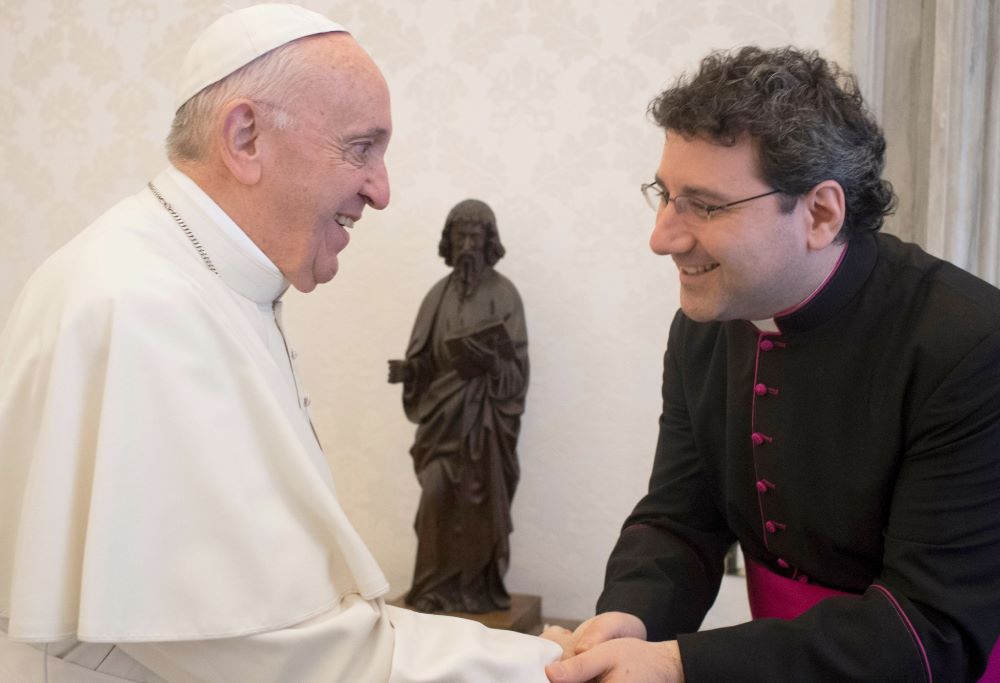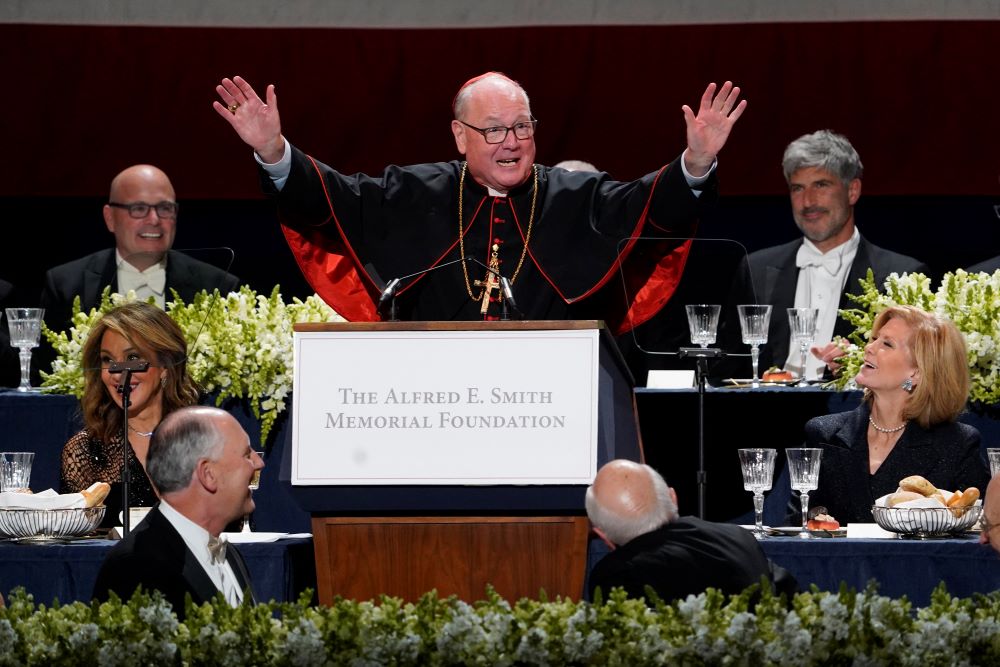
Pope Francis greets then-Msgr. Frank Leo of Montreal during a meeting at the Vatican Dec. 6, 2018. The Vatican announced Feb. 11 that Francis had accepted the resignation of Cardinal Thomas Collins as archbishop of Toronto and named Archbishop-designate Leo as his successor. (OSV News/Vatican Media)
Late last month, Pope Francis named Bishop Luc Terlinden as the new archbishop of Malines-Brussels, the primatial see of Belgium. The new archbishop is 54 years old.
Earlier in June, the Holy Father appointed Bishop José Cobo Cano, an auxiliary bishop of Madrid, as the new archbishop of that same city. Madrid is not the primatial see in Spain; that honor belongs to Toledo. But it is still the nation's capital and makes the new archbishop the most prominent cleric in the country. He is 59 years old.
In May, Pope Francis named Bishop Jorge Ignacio García Cuerva, of the diocese of Rio Gallegos, as the new archbishop of Buenos Aires, the post the pope occupied when he was elected pope in 2013. He is 55 years old.
Back in February, the pope named a new archbishop of Toronto, a city long associated with the British and Protestant history of the country. The primatial see of Canada remains Quebec, but Toronto is the country's largest city and many immigrants who have swelled the city's population are Roman Catholic. The pope named Bishop Frank Leo, an auxiliary in Montreal, to the important post, even though Leo is only 52 years old and had been a bishop less than a year.
These are all legacy appointments, archbishops in key cities who will shape the public face of the Catholic Church in their countries for a couple decades. In searching for candidates, the pope has let it be known he wants men with pastoral experience, and all these nominees have that. For example, Archbishop-elect Terlinden was vicar at the church of St. Francis of Assisi in Louvain-la-Neuve while serving as vocations director, and more recently served as a curé at a grouping of churches into one parish in a neighborhood in Brussels. Archbishop-elect Cobo served as a parish priest in Madrid for 15 years.
It is time for this pattern of legacy episcopal appointments to come to the United States. Earlier this year, my colleague Brian Fraga and I both wrote (here and here) about the large number of dioceses and archdioceses in which the incumbent hits the mandatory retirement age of 75 in the next couple years. Pope Francis needs to view them all as a chessboard, in which the next generation of episcopal leaders are vaulted into the most important sees.
Today, my concern is a little different. I want to make the case that in remaking the hierarchy, at least some of the appointments should be like those in Brussels, Madrid, Buenos Aires and Toronto, 20-year tenures, legacy appointments.
One historically significant archdiocese, Hartford, Connecticut, received its coadjutor archbishop last week when Pope Francis named Bishop Christopher Coyne of Burlington, Vermont, to the post. The announcement was something of a surprise, as the incumbent, Archbishop Leonard Blair, has no known health issues, the circumstance that usually mandates appointment of a coadjutor. Blair was best known for his role in the investigation of the Leadership Conference of Women Religious. His successor is a wonderful and gifted man, far more open to the paths being charted by Pope Francis. At 65, his is not exactly a legacy appointment, but it is a very hopeful sign.
Some of the more historically significant archdioceses, like Detroit where Archbishop Allen Vigneron turns 75 in October, are no longer the powerhouses they once were. When I visited there in May, several people spoke fondly of Bishop Daniel Flores, who served there as an auxiliary before becoming bishop of Brownsville, Texas. But Brownsville has close to 1.2 million Catholics, while Detroit only has slightly fewer at 1.1 million — and those are the numbers on paper. I suspect a far higher percentage of the poor people in Brownsville attend Mass regularly than the more affluent people in Detroit. And, in any event, after three cardinals in a row, Dearden, Szoka and Maida, it is unlikely Detroit will see another red hat.

New York Cardinal Timothy M. Dolan gestures as he brings the 77th annual Alfred E. Smith Memorial Foundation Dinner to a close at the Park Avenue Armory in New York City Oct. 20, 2022. Dolan turns 75 in February 2025. (CNS/Gregory A. Shemitz)
Cardinal Sean O'Malley, archbishop of Boston, turned 79 June 29. One of Pope Francis' closest advisers in the American hierarchy, he was allowed to stay on past the mandatory retirement age. However, 80 does seem to be a firm deadline, as even the pope's closest adviser, Honduran Cardinal Oscar Rodriguez, had his resignation accepted when he turned 80 at the end of 2022. Boston remains significant, as the archdiocese is the only religious player of any consequence in the Bay State. Its 1.9 million Catholics are 45% of the population.
Chicago Cardinal Blase Cupich turns 75 in March, but I am going to go out on a limb and bet that he, like O'Malley, will be invited to stay on past 75.
Two months later, Galveston-Houston Cardinal Daniel DiNardo hits 75, and I suspect his resignation will be accepted pronto! Galveston-Houston was only erected as an archdiocese in 2004, but it is fast growing, with 1.8 million Catholics. While there is no guarantee it will remain a cardinalatial see — DiNardo was the first — and San Antonio remains the older archdiocese of the state, I would not be surprised if one of the pope's favorite bishops, Bishop Mark Seitz of El Paso, was sent across the state to Houston. But at 69 already, his would not be a legacy appointment.
Advertisement
The most prominent archdiocese in the country is that of New York, and Cardinal Timothy Dolan turns 75 in February 2025. Given the pope's age and health, no one knows if Francis will name Dolan's successor, but if he does, it will be his most important appointment. Pope John Paul II famously called Cardinal John O'Connor the "Archbishop of the Capital of the World" and despite all the many changes in the geopolitical situation of the world since then, New York still has unparalleled cultural heft and chutzpah. If the pope decides to draw from within the province, I would keep an eye on Bishop Douglas Lucia of Syracuse who, at 60, would make a big difference for a long time in New York or elsewhere.
I hope the pope is willing to throw long in some of these and other important appointments. Every appointment of a new bishop matters to the priests and people of that diocese to be sure, but some dioceses are especially important: those that house a seminary, for example, or one where the archbishop is automatically the head of a state Catholic conference.
The bench is not abundant, but it is deeper than it might first appear. There are very bright, very promising auxiliaries in several major cities. There are pastors of large parishes who could become a bishop tomorrow. I hope the pope, and those who serve him in this selection process, go beyond the usual suspects. The U.S. deserves some legacy appointments, too.







